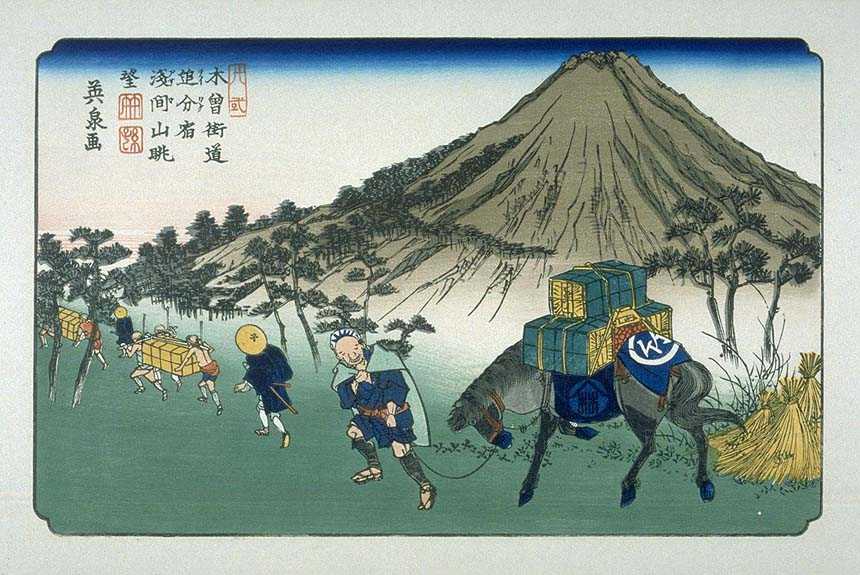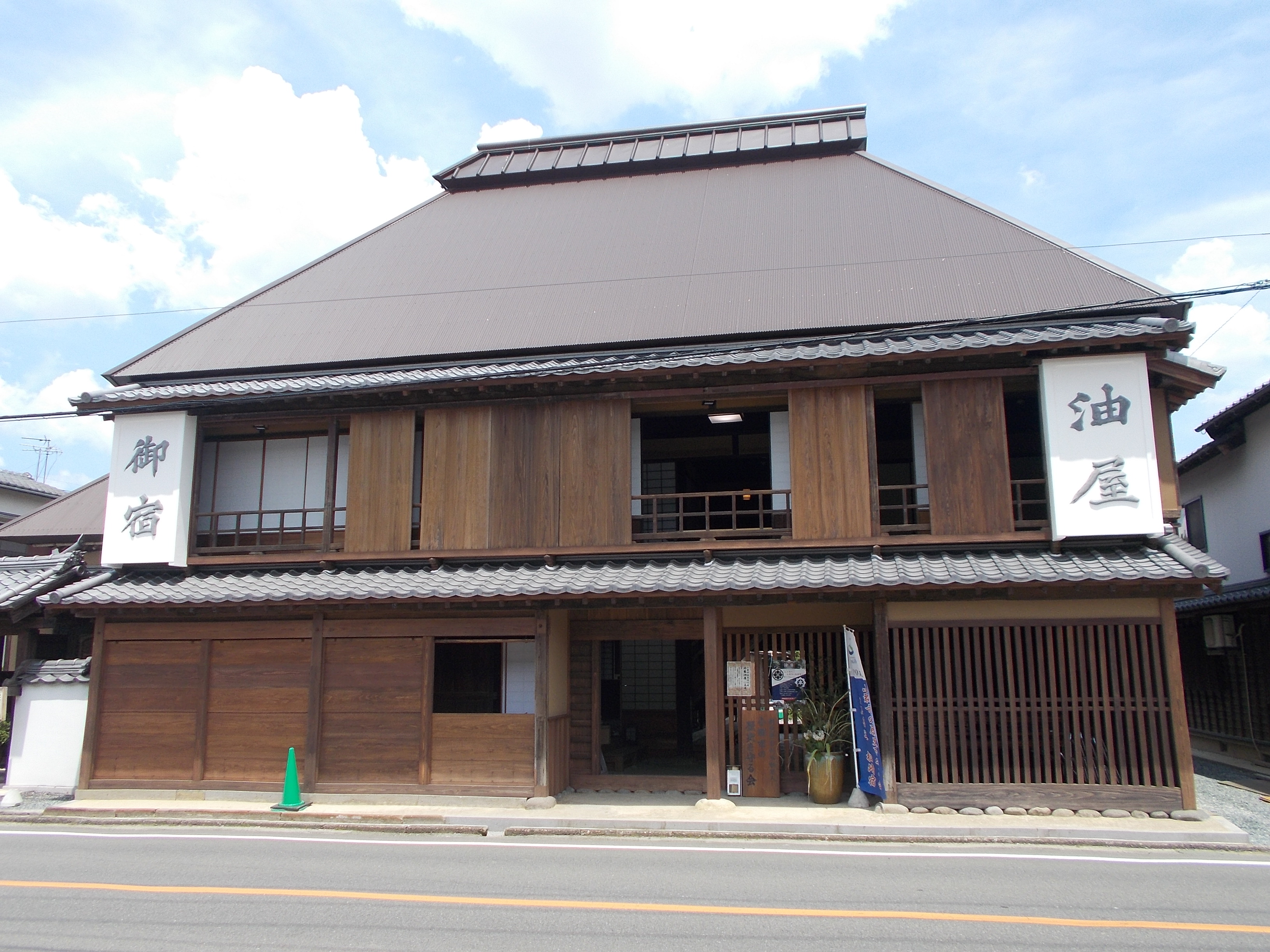|
Kameyama-juku
was the forty-sixth of the fifty-three stations (''shukuba'') of the Tōkaidō connecting Edo with Kyoto in Edo period Japan. It was located in former Ise Province in what is now the center of the city of Kameyama, Mie Prefecture, Japan. History Kameyama was the location of a castle built in the Kamakura period by the Seki clan to protect their territories in northern Ise. During the Sengoku period, Seki Kazumasa had been transferred from the clan's ancestral territory by Toyotomi Hideyoshi, but was restored as ''daimyō'' of Ise-Kameyama Domain by Tokugawa Ieyasu, and constructed a new Kameyama Castle. Along with the castle, he laid out the foundations for a new castle town, which due it its position on the Tōkaidō, was also a post town. Unlike other post towns, Kameyama-juku had two large fortified gates at either end, which also served as part of the defenses of the castle. The Ego-guchi gate was completed in 1673 and faced towards Edo. It measured 120 meters east-to-we ... [...More Info...] [...Related Items...] OR: [Wikipedia] [Google] [Baidu] |
Ise-Kameyama Domain
was a Han (Japan), feudal domain under the Tokugawa shogunate of Edo period Japan, located in Ise Province in what is part of now modern-day Kameyama, Mie. It was centered around Kameyama Castle (Mie), Ise-Kameyama Castle. Ise-Kameyama Domain was controlled by ''fudai daimyō'' clans throughout most its history. History The Ise-Kamayama area of northern Ise Province was controlled in the Sengoku period by Seki Morinobu. Under Toyotomi Hideyoshi, his son Seki Kazumasa was relocated to Mino Province and replaced by Hideyoshi's general Okamoto Yoshikatsu as part of a 22,000 ''koku'' fief. Okamoto Yoshikatsu rebuilt Kameyama Castle and laid out the foundations for the jōkamachi, castle town. However, he sided with the pro-Toyotomi Western Army at the 1600 Battle of Sekigahara and was dispossessed by the victorious Tokugawa Ieyasu, who restored Seki Kazumasa to his former domains with an increase in ''kokudaka'' to 30,000 ''koku''. Under Seki Kazumasa, Kameyama-juku, the shukuba, pos ... [...More Info...] [...Related Items...] OR: [Wikipedia] [Google] [Baidu] |
Seki-juku (Tōkaidō)
was the forty-seventh of the fifty-three stations of the Tōkaidō connecting Edo with Kyoto in Edo period Japan. It was located in former Ise Province in what is now the Seki neighborhood of the city of Kameyama, Mie Prefecture, Japan.Mie Tourism Guide: Ancient Tokaido Seki-juku Mie Prefecture. Accessed November 29, 2007. History Seki-juku is located on the main route from to the , and was always a major intersection for travel, with the , a highway for pilgrims to the Ise Grand Shrines and the , ...[...More Info...] [...Related Items...] OR: [Wikipedia] [Google] [Baidu] |
Kameyama, Mie
260px, Seki-juku (Tōkaidō) is a city located in northern Mie Prefecture, Japan. , the city had an estimated population of 49,457 in 21,745 households and a population density of 260 persons per km². The total area of the city is . Geography Kameyama is located in the north-central part of Mie Prefecture. The Suzuka Mountains are in the northwestern part of the city, and the Nunobiki Mountains are in the southwestern part. More than half of the city's area is forest. Neighboring municipalities Mie Prefecture * Iga * Suzuka * Tsu Shiga Prefecture * Kōka Climate Kameyama has a Humid subtropical climate (Köppen ''Cfa'') characterized by warm summers and cool winters with light to no snowfall. The average annual temperature in Kameyama is . The average annual rainfall is with September as the wettest month. The temperatures are highest on average in August, at around , and lowest in January, at around . Demographics Per Japanese census data, the population of Kameyama h ... [...More Info...] [...Related Items...] OR: [Wikipedia] [Google] [Baidu] |
Shōno-juku
was the forty-fifth of the fifty-three stations (''shukuba'') of the Tōkaidō connecting Edo with Kyoto in Edo period Japan. It was located in former Ise Province in what is now the city of Suzuka, Mie Prefecture, Japan. History Shōno-juku was established in 1624 and was thus the last post station to be established on the Tōkaidō. The reason for its establishment is unclear, but it was built at a pre-existing settlement. The scale of the post station was small, and the number of visitors staying was few, leading the shogunate in 1815 to halve the number of people authorized to man the two official ''honjin''. Per the 1843 guidebook issued by the , the town had a population of 855 with one ''honjin'', one ''wakihonjin'', and 15 ''hatago''. It had one ''Tonyaba'', for the stabling of packhorses and warehousing of goods, and one ''kōsatsu'' for the display of official notifications. It was 400.9 kilometers from Edo. The distance between neighboring Ishiyakushi-juku and Sh ... [...More Info...] [...Related Items...] OR: [Wikipedia] [Google] [Baidu] |
53 Stations Of The Tōkaidō
The are the rest areas along the Tōkaidō (road), Tōkaidō, which was a coastal route that ran from Nihonbashi in Edo (modern-day Tokyo) to Sanjō Ōhashi in Kyoto.. There were originally 53 government shukuba, post stations along the Tōkaidō, where travelers had to present traveling permits at each station if wanting to cross. In 1619, the Ōsaka Kaidō (大阪街道) was developed to extend the Tōkaidō so that it would reach Kōraibashi in modern-day Osaka. Instead of going to Sanjō Ōhashi, travelers would leave from Ōtsu-juku and travel towards Fushimi-juku (Tōkaidō), Fushimi-juku. Because of the addition of these four post towns, the Tōkaidō is occasionally referred to as having 57 stations. Another name for this extension was Kyōkaidō (京街道). The inland Nakasendō also started at Nihonbashi, and converged with the Tōkaidō at Kusatsu-juku. Shio no Michi intersected with the Tōkaidō at Okazaki-shuku. Stations of the Tōkaidō File:NihombashiDat ... [...More Info...] [...Related Items...] OR: [Wikipedia] [Google] [Baidu] |
Kameyama Castle (Mie)
is a Japanese castle located in Kameyama, northern Mie Prefecture, Japan. At the end of the Edo period, Kameyama Castle was home to the Ishikawa clan, ''daimyō'' of Ise-Kameyama Domain. The castle was also known as . History The original Kameyama Castle was founded by Seki Sanetada in 1264 to the west of the present Kameyama Castle, and was one of the five fortifications guarding the clan domains in northern Ise Province. It came under occasional attack by the Oda clan to the north, and was overrun when Oda Nobunaga extended his authority over Ise Province. In 1583, Hideyoshi defeated Takigawa Kazumasu at Kameyama castle. When Seki Kazumasa was relocated to Shirakawa in 1590, Okamoto Munenori, a retainer of Toyotomi Hideyoshi was given control of the castle. Okamoto moved the castle to the southeast and reconstructed all the main structures. [...More Info...] [...Related Items...] OR: [Wikipedia] [Google] [Baidu] |
Ukiyo-e
is a genre of Japanese art that flourished from the 17th through 19th centuries. Its artists produced woodblock printing, woodblock prints and Nikuhitsu-ga, paintings of such subjects as female beauties; kabuki actors and sumo wrestlers; scenes from history and folk tales; travel scenes and landscapes; Flora of Japan, flora and Wildlife of Japan#Fauna, fauna; and Shunga, erotica. In 1603, the city of Edo (Tokyo), Edo (Tokyo) became the seat of the ruling Tokugawa shogunate. The class (merchants, craftsmen and workers), positioned at the bottom of Four occupations, the social order, benefited the most from the city's rapid economic growth. They began to indulge in and patronize the entertainment of kabuki theatre, geisha, and oiran, courtesans of the Yūkaku, pleasure districts. The term ('floating world') came to describe this hedonistic lifestyle. Printed or painted ukiyo-e works were popular with the class, who had become wealthy enough to afford to decorate their homes wit ... [...More Info...] [...Related Items...] OR: [Wikipedia] [Google] [Baidu] |
Utagawa Hiroshige
or , born Andō Tokutarō (; 1797 – 12 October 1858), was a Japanese ''ukiyo-e'' artist, considered the last great master of that tradition. Hiroshige is best known for his horizontal-format landscape series '' The Fifty-three Stations of the Tōkaidō'' and for his vertical-format landscape series '' One Hundred Famous Views of Edo''. The subjects of his work were atypical of the ''ukiyo-e'' genre, whose typical focus was on beautiful women, popular actors, and other scenes of the urban pleasure districts of Japan's Edo period (1603–1868). The popular series '' Thirty-six Views of Mount Fuji'' by Hokusai was a strong influence on Hiroshige's choice of subject, though Hiroshige's approach was more poetic and ambient than Hokusai's bolder, more formal prints. Subtle use of color was essential in Hiroshige's prints, often printed with multiple impressions in the same area and with extensive use of '' bokashi'' (color gradation), both of which were rather labor-intensive ... [...More Info...] [...Related Items...] OR: [Wikipedia] [Google] [Baidu] |
Kōsatsu
A kōsatsu (, literally "High plaque"), also called Seisatsu (, literally "Controlling plaque"), was a public notice of the han-lord's or shogun's proclamations earlier in Japanese history. They were local or nationwide laws written on a wooden plate, placed in the ''kōsatsu-ba'' of the ''shukuba'' or '' sekisho'' ( 関所), the border between han, where there was frequent traffic. The kōsatsu was used from the late Nara Period until the early Meiji period. One of the kosatsu in the Edo Period was on prohibiting Christianity. As the people's literacy rate improved and the modern nation emerged, the kōsatsu was abolished in 1873 and eventually replaced by the Kanpō (Japanese government gazette) and other means of public notice. See also *Public notice *Kanpō *Bulletin board *Wall newspaper A wall newspaper or placard newspaper is a hand-lettered or printed newspaper designed to be displayed and read in public places both indoors and outdoors, utilizing vertical surfaces ... [...More Info...] [...Related Items...] OR: [Wikipedia] [Google] [Baidu] |
Hatago
were Edo period lodgings for travelers at ''shukuba'' (post stations) along the national highways, including the Edo Five Routes and the subroutes. In addition to a place to rest, ''hatago'' also offered meals and other foods to the travelers. They were also called . Name origin ''Hatago'' means "traveling basket." The word itself originally derived from baskets that contained food for horses and were carried by travelers. From there, it became a tool with which travelers were carry their own food and goods. Shops that began preparing and selling food for travelers gained the suffix , meaning "shop," but this was eventually shortened to just ''hatago''. Preserved ''hatago'' Because many post stations along the Tōkaidō, Nakasendō The , also called the ,Richard Lane, ''Images from the Floating World'' (1978) Chartwell, Secaucus ; pg. 285 was one of the centrally administered Edo Five Routes, five routes of the Edo period, and one of the two that connected the ''de facto'' ... [...More Info...] [...Related Items...] OR: [Wikipedia] [Google] [Baidu] |




